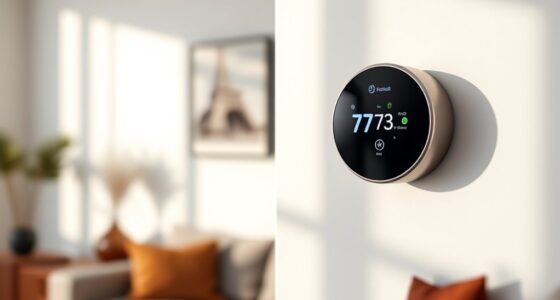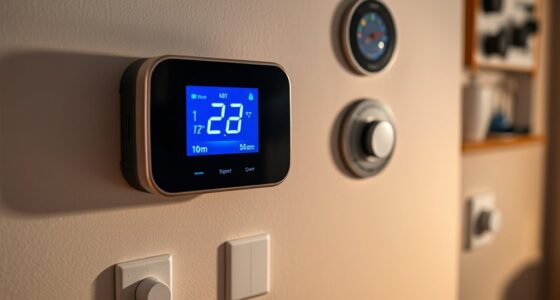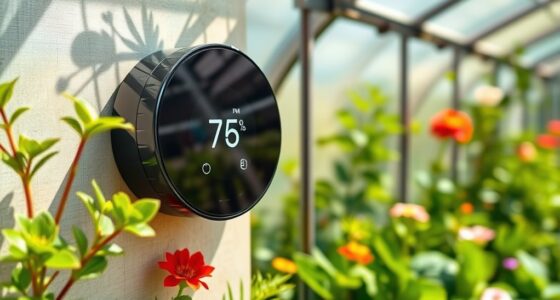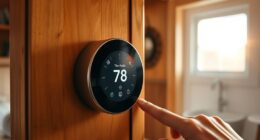Before buying a smart thermostat, check your home’s wiring and power source options. Determine if your system is wired or battery-powered and verify if a common wire (C-wire) is available, as some models need it for consistent power. Make sure your electrical system supplies the correct voltage and current. Confirm wireless compatibility with your home network. Continuing further will help you understand how to guarantee a seamless setup and reliable operation.
Key Takeaways
- Confirm if the existing thermostat wiring includes a C-wire for continuous power, or if a compatible model supports no C-wire setup.
- Determine whether your thermostat is hardwired or battery-powered to choose the appropriate power source option.
- Verify your home’s electrical system supplies the correct voltage and current for the thermostat’s operation.
- Ensure the wiring setup and compatibility support the smart thermostat’s features and installation requirements.
- Check wireless network compatibility and signal strength for seamless integration with your home Wi-Fi.

Next, consider your power source options. Most smart thermostats are designed to be either hardwired into your home’s electrical system or powered by batteries. If you’re replacing an existing thermostat, determine whether it’s wired or battery-powered. Some models offer dual power options, giving you flexibility to choose what works best for your home. If you opt for a battery-powered thermostat, remember that batteries will need periodic replacing or recharging. Conversely, hardwired models draw power directly from your HVAC system, providing consistent operation without the hassle of changing batteries. Make sure your home’s wiring can support the thermostat’s power requirements, or if it’s battery-operated, confirm that the batteries are easily accessible. It’s also helpful to verify whether your current wiring setup supports common wire connections, which are often necessary for certain smart thermostats. Additionally, evaluate whether your existing wiring is compatible with the new thermostat. Some models require common wire connections (often called a C-wire), which supplies continuous power. If your current setup doesn’t include a C-wire, you might need an adapter or consider a model designed to work without one. It’s wise to check whether your home’s electrical system supplies adequate voltage for the thermostat to operate correctly, preventing potential electrical issues. Failing to check this could result in installation issues or the need for additional wiring work. Also, determine if the thermostat’s power requirements align with your HVAC system’s voltage and current capacities to prevent any electrical problems. Furthermore, understanding your home’s wire configuration can help you choose a compatible model and avoid installation delays.
In essence, understanding your home’s wireless compatibility and power source options is vital before choosing a smart thermostat. These factors will impact installation, performance, and long-term reliability. Taking the time to verify these setup requirements ensures a smoother installation process and guarantees that your new device will work flawlessly within your existing home infrastructure. This way, you can enjoy the convenience, energy savings, and control that a smart thermostat promises without surprises or setbacks.
Frequently Asked Questions
Can I Install a Smart Thermostat on an Old or Incompatible HVAC System?
You might wonder if your old or incompatible HVAC system can support a smart thermostat. To find out, check your HVAC compatibility and wiring requirements. Older systems may lack the necessary wiring or modern features needed for seamless integration. If your system isn’t compatible, you could need additional wiring, adapters, or even a new system. Always review your HVAC’s specifications and consult a professional if you’re uncertain about compatibility.
Will My Wi-Fi Signal Affect the Smart Thermostat’S Performance?
Did you know that over 60% of smart device issues are caused by Wi-Fi problems? Your Wi-Fi signal strength directly impacts your thermostat’s performance, causing delays or connection drops. Signal interference from other electronics or thick walls can weaken the connection, affecting responsiveness. To make certain of smooth operation, place your router closer to the thermostat or reduce interference. Strong Wi-Fi guarantees your smart thermostat stays connected and functions flawlessly.
Do I Need Professional Installation or Can I Set It up Myself?
You might wonder if you can handle the setup yourself or need professional assistance. DIY installation is often straightforward if you’re comfortable with basic wiring and follow the instructions carefully. However, if you’re unsure about wiring or compatibility, seeking professional assistance guarantees safety and proper setup. Consider your comfort level and the complexity of your system to decide whether to go DIY or hire an expert.
What Is the Average Lifespan of a Smart Thermostat?
You might wonder about the average lifespan of your smart thermostat. Typically, it lasts around 10-15 years, but battery life can vary based on usage and model. Regular software updates help extend its functionality and security, potentially prolonging its lifespan. To maximize your device’s longevity, keep it updated and consider replacing batteries when needed. This guarantees your smart thermostat continues to perform efficiently over the years.
Are There Any Specific Safety Precautions During Installation?
Think of installation as guiding a safe harbor. You must prioritize electrical safety to prevent shocks and hazards. Always turn off power before working on wiring, and double-check equipment compatibility to avoid damage or malfunction. Use proper tools and follow manufacturer instructions carefully. By respecting these precautions, you guarantee a smooth, safe setup that keeps your home protected and your smart thermostat functioning perfectly.
Conclusion
Before you take the plunge, remember that a smart thermostat is like the conductor of your home’s comfort symphony. Check your wiring, compatibility, and Wi-Fi strength to guarantee it plays in harmony. Think of it as setting the stage for a cozy, energy-efficient performance. With everything in tune, you’ll enjoy seamless control and savings, turning your house into a well-orchestrated haven where comfort and technology dance together effortlessly.









